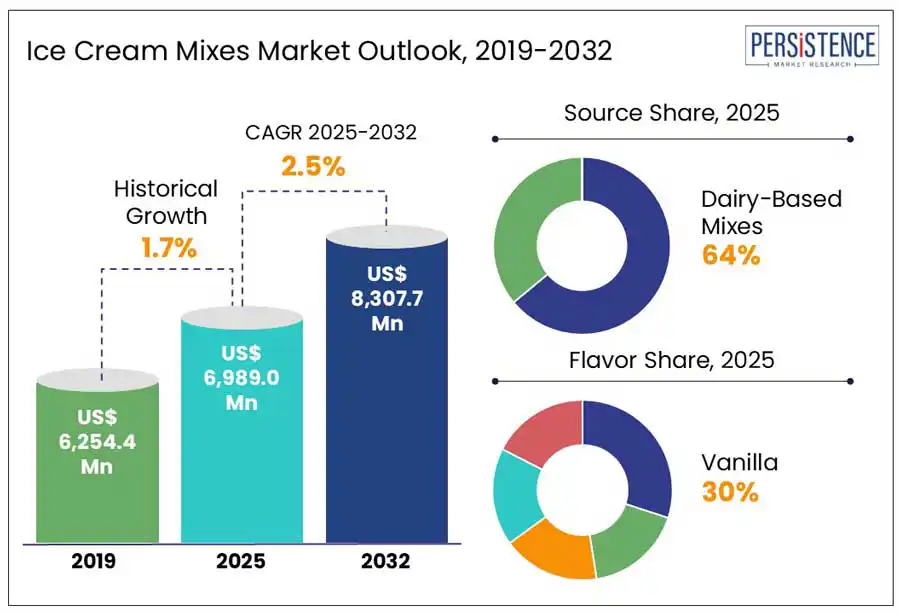Comprehensive Snapshot of Ice Cream Mixes Market Research Report, Including Regional and Country Analysis in Brief.
Industry: Food and Beverages
Published Date: April-2025
Format: PPT*, PDF, EXCEL
Delivery Timelines: Contact Sales
Number of Pages: 180
Report ID: PMRREP33055
The global ice cream mixes market size is anticipated to reach a value of US$ 6,989.0 Mn in 2025 and is set to witness a CAGR of 2.5% from 2025 to 2032. The market will likely attain a value of US$ 8,307.7 Mn in 2032. According to the Persistence Market Research report, the industry is evolving with trends emphasizing convenience, innovation, and health-consciousness. Consumers increasingly prefer pre-mixed bases for their ease of use and consistent quality, catering to commercial and home applications.
Rising demand for innovative flavors, such as exotic or artisanal options is driving growth. Healthier alternatives, including vegan, organic, gluten-free, and low-fat mixes, are gaining traction as dietary preferences shift. The market is also influenced by urbanization and fast-paced lifestyles, which favor ready-to-use products. Additionally, digital platforms are expanding accessibility to ice cream mixes globally. Manufacturers are focusing on clean-label formulations and regional diversification to meet diverse consumer needs.

Key Industry Highlights:
|
Global Market Attribute |
Key Insights |
|
Ice Cream Mixes Market Size (2025E) |
US$ 1,069.4 Mn |
|
Market Value Forecast (2032F) |
US$ 1,504.8 Mn |
|
Projected Growth (CAGR 2025 to 2032) |
5.0% |
|
Historical Market Growth (CAGR 2019 to 2024) |
4.1% |
Consumers are depending on products that simplify the process of making high-quality ice cream at home or in commercial settings, while also allowing customization and experimentation with flavors and ingredients. This trend is particularly pronounced in North America and Europe, where the popularity of premium, artisanal, and health-conscious ice cream options has surged. Simultaneously, consumers are becoming more health-conscious, which has resulted in consumption of food ingredients with added health advantages.
The production of ice cream mixes depends on various raw materials extracted from plants and animal-based sources. Due to climatic conditions, several plant-based raw materials are beyond production. For example, coconut base is used for coconut-based ice cream mixes. Due to unfavorable climate, it is not produced globally; the fruit is either exported from Latin America or Asia Pacific countries where coconuts are available in abundance.
Brazil remained the top coconut producing country till 2010; followed with Asian countries such as Philippines currently accounting as a major coconut producing country. Nearly 90% of the global coconut supply goes through Asia. The Philippines is a major exporter of coconuts to the U.S. and rest of the world.
A growing opportunity in the ice cream mixes market is the rising demand for health-focused and specialty products. More consumers today are looking for options that support their wellness goals and dietary preferences, with greater attention to ingredient transparency. This shift has led to increased interest in low-sugar, low-fat, dairy-free, and plant-based mixes. In response, brands are developing keto, vegan, and functional blends with added protein, probiotics, or vitamins. There's also a strong momentum behind clean-label and allergen-free offerings with natural bases such as almond, coconut, and oat becoming widely accepted. These evolving preferences continue to reshape innovation across the category.
Dairy-based mixes continue to dominate the market due to their rich taste, creamy texture, and strong consumer preference for traditional indulgence. According to the U.S. Department of Agriculture (USDA), in 2021, Americans consumed an average of 12.0 pounds of regular ice cream per person, highlighting the ongoing popularity of dairy-based frozen treats. This demand drives consistent use of dairy-based mixes in production. Federal standards mandating minimum milk fat content contribute to the flavor of these products. With innovation in whole milk and diverse flavor combinations, dairy-based mixes maintain their market leadership despite growing interest in plant-based alternatives.
Vanilla leads the ice cream flavor category due to its versatility, familiarity, and wide acceptance as a foundational flavor. Vanilla, as a flavor is neutral enough to be consumed as a flavor alone. Due to its flavor profile, vanilla makes an excellent base for additional flavors and toppings such as fruits, chocolate, and nuts. A significant portion of vanilla's appeal comes from its use as a key component in many popular desserts, such as cakes and custards. Vanilla is a safe and delicious option for kids and adults which makes it more popular overall.

North America is the leading region in the ice cream mixes market, largely driven by the U.S., where ice cream remains a staple dessert. The U.S. is one of the world’s largest consumers of ice cream, with the International Dairy Foods Association reporting that Americans consume around 23 pounds of ice cream per person each year. The country also boasts a strong manufacturing base, with hundreds of ice cream producers and a well-established dairy supply chain that supports large-scale production of mixes. Innovation plays a key role, with growing demand for organic, low-sugar, and plant-based options contributing to market expansion.
Europe holds a strong position in the ice cream mixes market, supported by a rich tradition of artisanal and premium ice cream consumption. Among European countries, Germany stands out as a leading market, with annual per capita ice cream consumption reaching approximately 8 liters. German consumers show a strong preference for both traditional and innovative flavors, as well as clean-label and organic ingredients. The region benefits from advanced food processing technologies and stringent quality standards, encouraging consistent demand for high-quality ice cream mixes. Additionally, the rising popularity of gelato and low-lactose alternatives across countries like Italy supports steady market growth.
East Asia is expected to witness growth in the ice cream mixes market, driven by increasing urbanization, rising disposable incomes, and a growing preference for Western-style desserts. In countries like China, ice cream consumption has surged, with the country becoming the world’s third-largest consumer of ice cream in recent years. China’s per capita consumption is expected to rise steadily, fueled by the expanding middle class and greater exposure to global food trends. The demand for premium, diverse flavors, including green tea, red bean, and fruit-based options, is also rising, while India’s emerging market sees growing popularity of both traditional and innovative ice cream products. The rise of e-commerce platforms and convenience stores in Asia has made ice cream mixes more accessible, further contributing to the region's rapid market growth.
The global ice cream mixes market features established players and emerging brands, fostering intense competition. Key strategies include product innovation, geographic expansion, and strategic partnerships. Companies focus on developing novel flavors and healthier options to gain market share. Competition is also driven by pricing, marketing, and distribution efficiencies.
|
Report Attribute |
Details |
|
Historical Data/Actuals |
2019 - 2024 |
|
Forecast Period |
2025 - 2032 |
|
Market Analysis Units |
Value: US$ Mn, Volume: As applicable |
|
Geographical Coverage |
|
|
Segmental Coverage |
|
|
Competitive Analysis |
|
|
Report Highlights |
|
|
Customization and Pricing |
Available upon request |
By Source
By Flavor
By Form
By Distribution Channel
By Region
To know more about delivery timeline for this report Contact Sales

The global market is estimated to increase from US$ 6,989.0 Mn in 2025 to US$ 8,307.7 Mn in 2032.
The global market is driven by rising demand for convenience, diverse flavors, health-conscious options, and increased consumption of frozen desserts drives the global ice cream mixes market.
The market is projected to record a CAGR of 2.5% during the forecast period from 2025 to 2032.
Opportunities include growth in plant-based, low-calorie, clean-label mixes, emerging market expansion, and innovation in functional and specialty ice cream products.
Major players include AAK AB, Classic Mix Partners, Dairy-Mix, Inc., Scott Brothers Dairy Inc., Bondi Ice Cream Co., Meadowvale, and others.